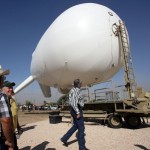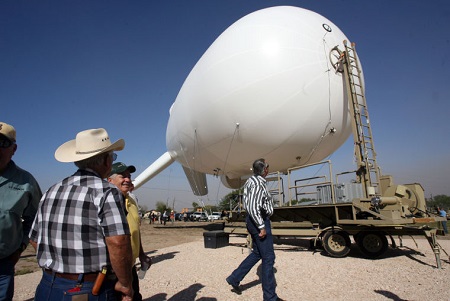By Dan Santella – The Monitor
It’s a bird, it’s a plane, it’s … no, it’s a Border Patrol blimp. Mobile, unmanned, aerial security surveillance has arrived in the Rio Grande Valley.
A so-called aerostat surveillance blimp was unveiled to media Thursday afternoon in a field south of Interstate 2/Expressway 83. Standing behind a U.S. Department of Homeland Security dais, local and national officials introduced the big, white airship and fielded questions about its upcoming use.
Noting how border fencing ends near Peñitas, Rosendo Hinojosa, chief patrol agent of the Border Patrol’s Rio Grande Valley Sector, said that the aerostat will provide Valley authorities with means previously unavailable to them.
“This is good technology,” he said of the camera-bearing aircraft, which will roam 1,000 feet above the ground. “It’s proven technology.”
On Tuesday in Penitas, local land owners look over an aerostat that will aid in surveillance and be launched by the U S Border Patrol Rio Grande Valley Sector.
Photo: Joel Martinez/The MonitorSurveillance conducted by the aerostat is a joint venture shared by the Defense Department and U.S. Customs and Border Protection, according to a CBP news release. Hinojosa said that this aerostat, formerly used in American combat in Afghanistan, will be deployed in Peñitas for “a testing (and) evaluating period” lasting six months.
Hinojosa spoke positively to what the aerostat can accomplish given what he described as a recent, regional trend of “elevated flow rates” in illicit border traffic.
“More technology and resources are coming down this way,” he said, noting how in the previous year 600 new security personnel have been allocated to the Valley. Border Patrol spokesman Danny Tirado said that 300 agents have arrived, with the second 300 still to come. All will be employed by Border Patrol.
John Milne, a CBP supervisor, said the aerostat’s camera has a range between 5 and 10 miles, and the aircraft is also equipped with infrared technology.
Milne sought to allay any concern that the aerostat would infringe on any local resident’s right to privacy.
“It’s not different than anything else,” Milne said, referring to other surveillance and security systems. “These cameras cannot look inside people’s windows.”
Hinojosa agreed, saying that the aerostat and its surveillance technology are “not going to be used against the citizenry.”
At least two local landowners were decidedly in favor of the aerostat’s deployment. Mauro Reyna of Peñitas described the aerostat’s deployment as “another level of law enforcement.”
“The illegal traffic out here is really bad,” he said. The aerostat “will lead to a safer community.”
Mario Flores, owner of a Starr County ranch, called the illegal traffic “out of control” and expressed concern for the safety of his loved ones.
“You want to (be able to) go to the ranch and be safe,” he said.
Tirado said that Border Patrol will manage the surveillance conducted by the aerostat, saying that the camera onboard the aircraft will be used 24 hours a day and seven days a week. He said that a matching aircraft has been deployed in Sullivan City, with another set to lift off in Brooks County in January.
Source: Valley Morning Star


